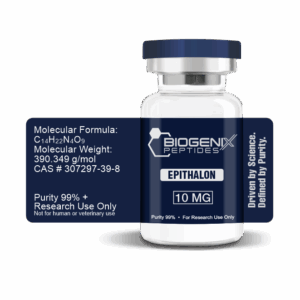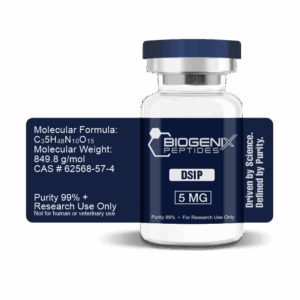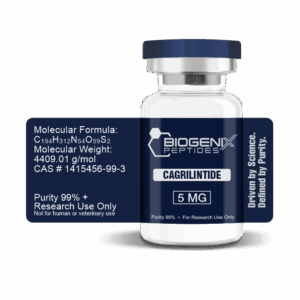Description
BPC-157 (Pentadecapeptide BPC-157): Research
Overview
Abstract
BPC-157 (Body Protection Compound-157) is a synthetic pentadecapeptide derived from a partial sequence of human gastric juice protein. Preclinical investigations have explored its potential roles in angiogenesis, wound healing, musculoskeletal repair, gastrointestinal protection, and neuroprotection. While promising, it is important to note that BPC-157 remains an experimental compound and is not approved for human or veterinary use outside of research contexts..
Molecular Profile
Molecular Formula C₆₂H₉₈N₁₆O₂₂ Molecular Weight ̃1419 Da Structure Fifteen amino acids (Gly-Glu-Pro-Pro-Pro-Gly-Lys-Pro-Ala-Asp-Asp-Ala-Gly-Leu-Val) Classification Synthetic peptide; classified under ‘research use only’ reagents
Research Findings
Angiogenesis and Tissue Regeneration: BPC-157 has been shown to upregulate vascular endothelial growth factor (VEGF) and modulate signaling pathways such as ERK1/2, FAK/paxillin, and Egr-1. These processes appear to support endothelial migration, blood vessel formation, and extracellular matrix remodeling in preclinical models. Musculoskeletal Applications: Rodent studies demonstrate accelerated healing of tendons, ligaments, and skeletal muscle under stress or injury. Mechanistically, BPC-157 has been associated with fibroblast recruitment, collagen synthesis, and enhanced biomechanical recovery in tendon-to-bone junctions. Gastrointestinal Protection: Research indicates a potential protective role in gastric and intestinal ulcer models, possibly through modulation of nitric oxide pathways and angiogenic repair. Studies suggest improved healing across various sections of the GI tract, including esophageal and colonic injury models. Neuroprotective and Organ-Protective Properties: Preclinical work has suggested protective effects against traumatic brain injury, hepatic and pancreatic lesions, and vascular disruptions. Some evidence also points toward interactions with dopaminergic signaling and neuroinflammatory modulation.
Proposed Mechanisms of Action
- Regulation of growth hormone receptor activity.
- Upregulation of VEGF and related angiogenic cascades.
- Modulation of nitric oxide synthase (NOS) pathways.
- Influence on neurotransmitter systems, particularly dopamine.
- Enhancement of fibroblast activity, collagen deposition, and cell survival.
Quality and Verification
All available research-grade BPC-157 is typically provided as a lyophilized powder with a stated purity of ³99%. Standard characterization includes:
- High-Performance Liquid Chromatography (HPLC)
- Mass Spectrometry Analysis
- Certificate of Analysis (COA) accompanying each batch
Regulatory and Ethical Considerations
- Status: Not FDA-approved; not classified as a drug, biologic, or therapeutic agent.
- Intended Use: Research purposes only. Not for human consumption, clinical use, or diagnostic application.
- Caution: Any extrapolation of preclinical findings to clinical outcomes remains speculative until validated through peer-reviewed human trials.
Selected References
- Sikiric, P. et al. (2018). The stable gastric pentadecapeptide BPC 157 and its role in angiogenesis, wound healing, and tissue regeneration. Current Pharmaceutical Design, 24(18), 2009-2028.
- Chang, C.H. et al. (2010). BPC-157 promotes tendon-to-bone healing in a rat model. Journal of Orthopaedic Research, 28(10), 1306-1311.
- Kang, E.A. et al. (2014). Therapeutic effects of BPC-157 on experimental colitis in rats. Digestive Diseases and Sciences, 59(6), 1212-1220.
- Vukojevic, J. et al. (2017). Neuroprotective potential of BPC-157 in models of brain injury. Peptides, 95, 11-19.
Disclaimer
BPC-157 is provided solely for laboratory and preclinical research. It has not been evaluated for safety, efficacy, or clinical application. All descriptions herein summarize published experimental findings and should not be interpreted as medical advice




Reviews
There are no reviews yet.